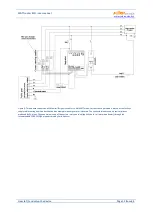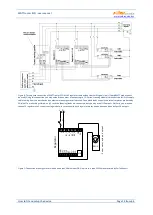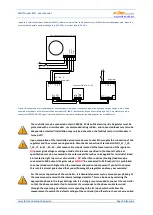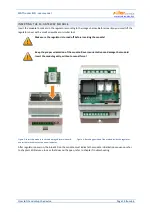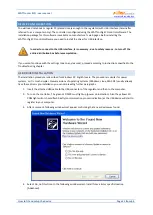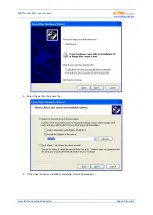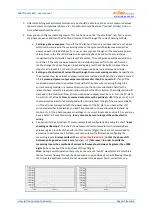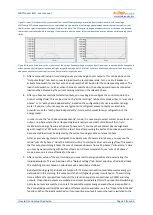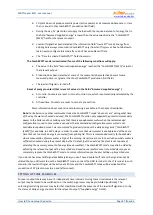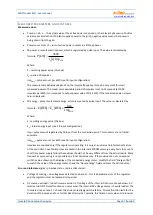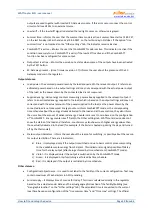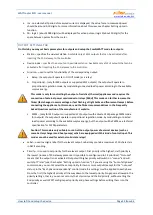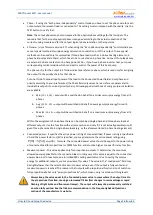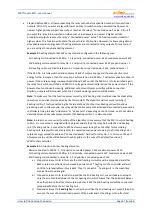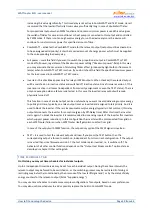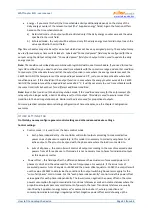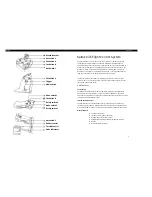
WATTrouter ECO - user manual
www.solarcontrols.cz
How to fit and setup the device
Page 26 from 66
value specified in the Maximum power field), the system waits until the power output of PV-plant
increases again (sunrise). If additional available surplus energy is determined when the load with first
priority is switched on, then load with second priority is switched on in the same mode. The same
applies to all outputs. If the available surplus energy decreases, or if another load in the household is
switched on, active outputs are disconnected according to preset priorities but in reverse order (first,
the load with the lowest priority gets disconnected).
The value in the "Connected power" field should be equal to the power rating of the connected load.
For relay output it must be higher or equal to the power rating of the load, otherwise the controller
will not operate correctly, and the load will be repeatedly turned on and off. For proportional output
this value only configures the control dynamics, but it should be also equal to the actual power rating
of the load.
The fields On-delay time and Off-delay time for relay outputs specify the time delay to switch the relay
on or off after a condition has been detected to do so. This feature is necessary for loads which cannot
be switched on frequently.
Set outputs according to the connected loads and based on your priorities and then press the Write
button. The configuration will be saved in the controller. Now the main function of the controller
should be configured.
10.
Test the main function of the controller, or possibly, modify priorities for outputs and power settings
of connected loads.
SETTING UP COMBIWATT MODE
After you have successfully tested the main function, you may start to configure CombiWATT mode, provided a
low tariff signal is connected to the controller (it may be used even if single tariff rate is present – see notes
below). This can be done on the "Output settings" tab. CombiWATT mode provides constant daily energy
supply to the connected loads. This mode is indispensable if you need to heat up water but also e. g. if you use
a swimming pool filtering system during cloudy days or when your PV-plant is temporarily out of order. In
CombiWATT mode, energy is taken both from PV-plant and from public grid.
Determine the optimal value of energy in kWh for the connected load (for example for a boiler or immersion
heater), which you plan to supply the load with every day. For example, for a boiler it is suitable to determine
the value of electric energy based on the average consumption of warm water. Usually, electric energy
necessary to increase the temperature of water by 40°C equals to:
3600000
]
[
*
]
[
*
]
[
K
T
l
V
c
kWh
E
V
. If you
enter it into the formula you will get:
]
[
*
0464
.
0
]
[
l
V
kWh
E
. For a 180 liter boiler it will be 8.36 kWh. We
recommend to increase this value by the daily heat loss of the boiler and also to modify (reduce) the value
based on the actual average consumption of warm water.
Note:
If you are heating water for example, the controller does not "know" how hot the water in the boiler is
and therefore, the assumed values of the supplied electric energy may be higher than the actual delivered
energy (the boiler thermostat may shut it off at any time).
Mark the CombiWATT field for the relevant output (output must be activated, which means that the output
must be assigned with the relevant priority), enter the established value of the daily electric energy in kWh and
press the Write button. The configuration will be saved in the controller.
The CombiWATT mode is activated only if ALL the following conditions are met:
a.
The output is activated (priority has been assigned to the output - that means the output is
not in the "not used" status).

